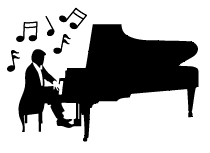(Down - Up - Top)
KT Intro.2 - The method of Franz Liszt
 |
Franz Liszt is widely regarded as the founder of play technique for the modern piano instrument.
Liszt himself studied with the legendary teacher Carl Czerny, who in turn was a student of Beethoven. They represent a musical 'bloodline' through which piano technique expertise was passed on in time.
Franz Liszt spent part of his earlier life in Paris where he had a great influence.
His piano technique method lives on in that city today through two of the world's leading piano teachers, Yvonne Loriod (widow of the composer Olivier Messiaen) and Germaine Mounier. My own teacher, Dr. Graham Williams, was taught by both these ladies when he studied at the Paris Conservatoire and the Ecole Normale de Music in Paris. |
This Piano Technique Course is an extension of the modern Liszt method.
It incorporates :
- Graham Williams' instructions as published in our jointly written book Scales & Arpeggios for the Jazz Pianist, and my six years of piano study with him.
- My own analysis of the anatomy of the hand as it applies to a correct piano technique.
- A series of technique exercises I especially wrote for this Course. They are similar to the ones by Liszt, Czerny, Poisot, Clementi, etc., but feature Jazz oriented harmonies.
(Down - Up - Top)
KT Intro.3 - What a Good Technique achieves
A good piano technique will :
- produce a crystal clear, focussed, resonant sound
Most piano players push the keys down. This produces either a crude blunt sound or a rather weak and thin tone.
Good pianists use the gravity force from the weight of their fingers, hand and arm. This produces (on the acoustic piano) a quite spectacular difference in resonance and overall tone quality, often not realised by the novice student.
- enable cleanly articulated even flowing passages at any speed
Nothing sounds laboured, muffled or irregular. All notes can be heard individually, but at the same time are fluently strung together in an apparently effortless manner.
- avoid repetitive strain injury (rsi)
The tendons of the flexor digitorium muscles move through the carpal tunnel under the wrist. Poor technique relies heavily on these muscles and often causes inflammation of the carpal tunnel and other muscle damage.